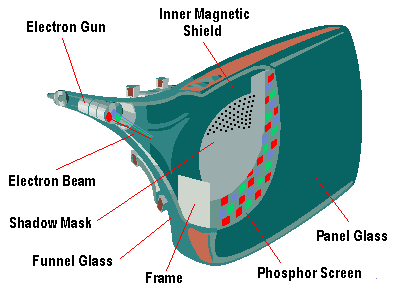Home How CRT's Work

A CRT is essentially an oddly-shaped, sealed glass bottle with no air inside. It begins with a slim neck and tapers outward until it forms a large base. The base is the monitor’s ‘screen’ and is coated on the inside with a matrix of thousands of tiny phosphor dots. Phosphors are chemicals which emit light when excited by a stream of electrons: different phosphors emit different colored light. Each dot consists of three blobs of colored phosphor: one red, one green, one blue. These groups of three phosphors make up what is known as a single pixel.
In the ‘bottle neck’ of the CRT is the electron gun, which is composed of a cathode, heat source and focusing elements. Color monitors have three separate guns, one for each phosphor color. Combinations of different intensities of red green and blue phosphors can create the illusion of millions of colors. This is called additive color mixing and is the basis for all color CRT displays.
Images are created when electrons, fired from the electron gun, converge to strike their respective phosphor blobs (triads) and each is illuminated, to a greater or lesser extent. When this happens, light is emitted, in the color of the individual phosphor blobs. The gun radiates electrons when the heater is hot enough to liberate electrons (negatively charged) from the cathode, which are then narrowed into a tiny beam by the focus elements. The electrons are drawn toward the phosphor dots by a powerful, positively charged anode, located near the screen.
The phosphors in a group are so close together that the human eye perceives the combination as a single colored pixel. Before the electron beam strikes the phosphor dots, it travels thorough a perforated sheet located directly in front of the phosphor layer known as the 'shadow mask'. Its purpose is to ‘mask’ the electron beam, forming a smaller, more rounded point that can strike individual phosphor dots cleanly and minimize ‘overspill’, where the electron beam illuminates more than one dot.
The beam is moved around the screen by magnetic fields generated through a deflection yoke. It starts in the top left corner (as viewed from the front) and flashes on and off as it moves across the row, or ‘raster’. When it impinges on the front of the screen, the energetic electrons collide with the phosphors that correlate to the pixels of the image that’s to be created on the screen. These collisions convert the energy into light. Once a pass has been completed, the electron beam moves down one raster and begins again. This process is repeated until an entire screen is drawn, at which point the beam returns to the top to start again.
The most important aspect of a monitor is that it should give a stable display at the chosen resolution and color palette. A screen that shimmers or flickers, particularly when most of the picture is showing white (as in Windows), can cause itchy or painful eyes, headaches and migraines. It is also important that the performance characteristics of a monitor be carefully matched with those of the graphics card driving it. It’s no good having an extremely high performance graphics accelerator, capable of ultra high resolutions at high flicker-free refresh rates, if the monitor cannot lock onto the signal.
